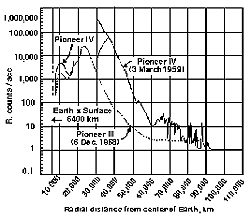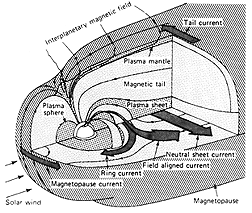
Clicking on any marked section on the list below brings up a
file containing it and all unmarked sections immediately
following it on the list. This list is repeated at the beginning of each file.

| Trapped radiation was however observed at much greater distances than albedo theory could explain. After the December 1958 flight of Pioneer 3, Van Allen and Fran [1959] concluded that there existed not one belt but two (Figure 3)--an "inner belt" created by albedo neutrons and an "outer belt" then believed to consist of energetic electrons from some other source, extending to distances of 6-8 RE (Earth radii) [Farley, 1963; O'Brien, 1963]. The outer belt was studied by Explorer 6, launched 7 August, 1959 [Naugle, 1965]. |
Figure 3. Counting rates of Pioneers 3 and 4, during traversals of the outer radiation belt [Van Allen and Frank, 1959].Yet another particle population was added on July 9, 1962, when the Defense Atomic Support Agency (DASA) and the Atomic Energy Commission (AEC) exploded a hydrogen bomb (a project code-named Starfish) in the inner belt region. The bomb created an intense belt of MeV electrons [Brown et al., 1963] which among other things damaged the solar arrays of satellites and caused three of them to fail soon afterwards. Some Starfish electrons persisted for five years [Hess, 1968], underscoring the long lifetime of particles in the inner belt. NASA was caught by surprise: it retrieved an engineering model of Explorer 12 from one of its museum displays, hurriedly turned it into a regular satellite and launched it as Explorer 15, all within 91 days [Corliss, 1967, p. 728]. The Department of Defense reacted even more quickly, launching Starad (1962bk; see Corliss [1967], p. 790) within 60 days of the decision to launch the mission (M. Walt, personal communication, 1995). Before the international test ban took place, Soviet Russia also exploded three large bombs, but these tests occurred on more distended field lines and their radiation belts only lasted a number of weeks [White, 1966].
At first it was held that the aurora was simply the overflow of the outer belt:
"... we propose that the radiation belt is the reservoir whose leakage of particles is the direct cause of visible aurora. It is further suggested that solar plasma replenishes the reservoir from time to time, working its way into the outer reaches of the earth's magnetic field when its density is sufficiently great, then being trapped in the field." [Van Allen et al., 1959].This was known as the "leaky bucket" theory, the bucket being the belt and the leak the aurora [O'Brien, 1967; Kennel, 1969, Fig. 15]. Later it was pointed out [Dessler, 1960] that the high electron fluxes attributed to the outer belt should have significantly deformed the magnetic field. An experiment aboard Explorer 12, designed to resolve the problem, showed a large flux of positive ions, presumably protons [Davis and Williamson, 1963, 1966], energetic enough to penetrate the counters; this component later turned out to contain most of the energy. The outer belt also contained energetic electrons, but their intensity fell far short of the level needed to produce the aurora [O'Brien, 1962, 1964]. Opinion then shifted to the alternative "splash catcher theory" by which some outside mechanism was producing auroral electrons and the outer belt was merely a by-product, incidental splash captured from the main torrent.
4. The Large-Scale Structure

| The picture became much clearer during 1962-5 [LeGalley, 1963], when the large-scale structure of the Earth's magnetic environment (named "magnetosphere" by Gold[1959]) was established (Figure 4). This phase followed the observational confirmation of the existence of the solar wind, predicted by Parker (see BH-1). In 1962 Explorer 12, on the sunward side of the Earth, repeatedly crossed a sharp boundary between the magnetosphere and the solar wind, named the "magnetopause" [Cahill and Amazeen, 1963; Cahill, 1995; Hines, 1963; Hess et al., 1965; Dungey, 1978] and resembling in many ways the boundary predicted (for storm times) by Chapman and Ferraro (see BH-1). |
Figure 4. Regions and currents of the Earth's magnetosphere, representing the state of our knowledge around 1970 [Lopex and Baker,1994]. A small normal field component on the magnetopause allows some interplanetary field lines to link up with the Earth's field.The following year Explorer 18 (or IMP 1, for Interplanetary Monitoring Platform) observed a collision-free bow shock ahead of the magnetopause [Ness et al., 1964], predicted by Axford [1962] and Kellogg [1962], and also established the properties of the long geomagnetic tail [Ness, 1965, 1987], briefly glimpsed in 1961 during the 52-hour mission of Explorer 10 [Heppner et al., 1963]. Those observations and others by Explorer 14 and the Vela satellites led to two predictions of a "tail" of the magnetosphere (Ness [1969], p. 100). Dessler and Juday [1965] predicted two bundles of magnetic flux trailing behind the Earth's poles, twisted by the Earth's rotation, with a current profile resembling the Greek letter theta. Axford et al. [1965] predicted similar "tail lobes" but also suggested a layer of plasma in the equatorial region between them, carrying a cross-tail current which then closed around the tail magnetopause, also with a q-profile. They furthermore suggested that the distant neutral line predicted by Dungey ([1991]; sect. 7, below) was embedded in that plasma sheet. IMP 1 and later IMPs confirmed Axford's plasma sheet, finding it typically 2-8 RE thick, with a dawn-to-dusk electric current of order 200,000 A/Earth Radius , and a plasma of about 0.5 ions/cc of ions of 1-5 keV and electrons around 1 keV. The plasma of the tail lobes was very rarefied, typically 0.01 ion/cc.
The tail contained two low-density "tail lobes", bundles of roughly parallel field lines directed sunward in the northern lobe and anti-sunward in the southern lobe, as required for field lines connected to the appropriate polar caps of the Earth (compare Dessler and Juday [1965]). Sandwiched between the lobes was a near-equatorial "plasma sheet." The fact that the sheet was bounded by oppositely directed magnetic fields showed that it carried a dawn-to-dusk electric current of the order of 200,000 A/RE, and this current closed around the magnetopause, giving the entire flow pattern the profile of the Greek letter theta [Axford et al., 1965; Axford, 1994]. I. Axford (personal communication, 1992) has claimed that this work predated the disclosure of IMP 1 results.
The earthward edge of the plasma sheet contained ions of about 20 keV, and these blended continuously with the ions of the ring current [Frank, 1971]; on the other hand, the energetic electron population of the sheet [Vasyliunas, 1968] displayed an asymmetrical inner edge. (Because of the presence of low-energy electrons, this does not contradict the plasma's electrical neutrality.) The inner edge was originally credited to electrons precipitated into the atmosphere by plasma instabilities [Kennel and Petschek, 1966] but in hindsight it might also be related to region 2 Birkeland currents (below), carried almost entirely by electrons.
The existence of a "ring current" circling the earth during magnetic storms was inferred long before the spaceflight era, from the magnetic signatures of such storms, and was the subject of extensive speculation [Smith, 1963]. Observations in space indicated that it was carried by trapped particles of relatively low energy, as had been suggested by Singer [1957], and that it was not a transient effect of storms but a permanent feature. It was studied (launch dates given as (mo.day.yr)) by the Orbiting Geophysical Observatories [Ludwig, 1963; Jackson and Vette, 1975] OGO-1 (9.5.64), OGO 3 (6.7.66) and OGO 5 (3.4.68), later by Explorer 45 ("Small Scientific Satellite" or S3; (11.15.71)) [Longanecker and Hoffman, 1973] and by the European GEOS 1 (4.20.77) and GEOS 2 (7.14.78). Its energy is mainly carried by ions with energies around 50 keV [Frank, 1967], but its exact composition and energy (median value about 85 keV) were only mapped by the Charge Composition Explorer (CCE) of the AMPTE mission, launched in 1984 [Williams, 1987; Lui and Hamilton, 1992].
The ring current grows stronger during magnetic storms, and it was shown theoretically that the intensity of the magnetic disturbance observed at Earth is then very nearly proportional to its total energy [Dessler and Parker, 1959; Sckopke, 1966; Carovillano and Siscoe, 1973]. Between such injections the ring current slowly decays, mostly by charge exchange collisions [Liemohn, 1961; Smith et al., 1976] with atoms of the hydrogen cloud ("geocorona") surrounding the Earth [Hunten and Donahue, 1976 ; Carruthers et al., 1976]. Each collision produces a slow proton and a fast neutral atom; such high-energy atoms are able to trigger particle counters, and since they are (like albedo neutrons) unaffected by the Earth's magnetic field, it has been proposed to use them for remote sensing of the ring current [Williams et al., 1992]. In 1971 it was also observed that a sizable portion (about 15%) of the particles added to the ring current during a magnetic storm were O+ ions of atmospheric origin, evidence of a near-earth acceleration process [Shelley et al., 1972].
A special region is the polar cusp, the region inside the high-latitude dayside magnetopause which separates field lines that close near the "nose" of the magnetosphere from those swept into the tail. The cusp was first explored in 1969-72 by the European spacecraft HEOS 1 and HEOS 2 (and later by Iowa's Hawkeye-1) which found a region of disordered weak magnetic fields [Mencke-Hansen, 1976]. Such fields are unable to exclude the solar wind, or more accurately, the magnetosheath plasma, a name given by Dessler and Fejer [1963; see Fig 1 there] to the solar wind plasma slowed and heated by passage through the Earth's bow shock. It is therefore filled with magnetosheath plasma, which spills into a funnel-shaped region reaching all the way to the atmosphere and produces a characteristic auroral glow [Shepherd, 1979].
The HEOS satellites also discovered a variety of boundary layers just inside the magnetopause, with a thickness of the order 0.3-1 RE, typical density 1-3 cm-3 and typical tailward velocity of 100-150 km/sec. A narrow "low latitude boundary layer" was found on the day side [Paschmann et al., 1976] and may be the result of reconnection processes (below) near the nose of the magnetosphere, though other origins are also possible. The much thicker "plasma mantle" found at high latitudes tailward of the cusp [Rosenbauer et al., 1975] may be formed by sheath plasma crossing an Alfvenic transition extending from the site of magnetic reconnection, discussed further below [Levy et al., 1964] , and it gradually widens with increasing distance from Earth [Hardy et al., 1975, 1979].
In what follows, coordinates in the magnetosphere will be given in the so-called geocentric solar magnetospheric coordinate system (GSM), described by Russell [1971; also Hapgood, 1992]. In these coordinates, the x-direction points to the Sun, the x-z plane contains the Earth's dipole axis and north is on the positive side of the plane z=0. The x-direction is also assumed to be the one from which the solar wind is blowing, although in very accurate work the small aberration angle (about 4 degrees) due to the Earth's orbital motion is also taken into account. The actually observed direction of the solar wind may differ from this by a few degrees (in both elevation and azimuth) due to effects occurring closer to the Sun.
"Exploration" home page ......... "Exploration" index
 Official GSFC Home Page .........
Official GSFC Home Page .........
 NASA WWW Home Page
NASA WWW Home Page
Last updated: October 16, 1997